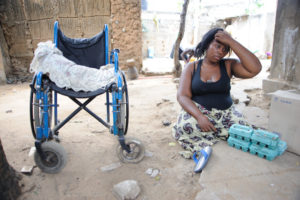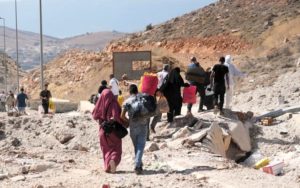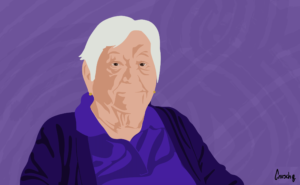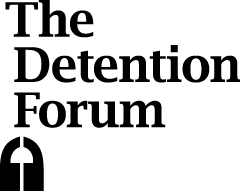By Jeff Crisp
In “Addressing the Inhumanity of Internal Displacement”, his new article for UAI, Jeff Crisp, one of the world’s leading authorities on refugee and displacement issues, reviews the report of a UN Panel on Internal Displacement. Crisp finds their recommendations ‘worthy’, but identifies many obstacles to their implementation. He also wonders if, in singling out people forced to leave their homes, but remaining in their own countries, for special attention, we may not inadvertently lose sight of the needs of people unable to move and clinging on in the rubble of their homes. Are governments and international organisations giving enough attention to ‘internally stuck people’?
A new report from a UN Panel seeks to transform the way in which states and the international community address the plight of people who are displaced within their own country, most commonly as a result of armed conflict. While the report presents a plethora of worthy recommendations, many obstacles stand in the way of their effective implementation.
International action
In 1986, I co-authored a book which observed that “nobody knows how many people have been displaced within their own country.” Unlike refugees, it pointed out, “there is no special agency to protect and assist such people. There is very little international law to regulate their treatment. As a result, many live in conditions of extreme insecurity and abject poverty.”
Since those words were written 35 years ago, numerous steps have been taken to address and ameliorate the plight of the world’s internally displaced people (IDPs).
In 1992, the United Nations appointed a Special Representative for IDPs, and six years later established a set of Guiding Principles, detailing the rights and forms of protection to which the internally displaced are entitled.
Over the past 15 years, legislation has been established at the national and regional levels to ensure that those rights are respected, while a growing number of states have adopted IDP policies explicitly based on the Guiding Principles.
At the same time, Intense advocacy has been undertaken on behalf of IDPs, involving NGOs, human rights organizations and civil society. In addition, the humanitarian sector has agonized for many years over the way that IDP protection and assistance can best be coordinated amongst the many different aid agencies involved in such work.
That issue was supposedly put to rest in 2005, when the so-called ‘Cluster Approach’ was introduced, its intention being to establish a clearer and more predictable division of labour amongst those organizations.
A global crisis
Despite all of these efforts, very little appears to have changed with respect to the challenges confronting those people who have been displaced within their own country.
According to a new report from a High Level Panel established by UN Secretary-General Antonio Guterres, in recent years there has been an “unrelenting climb” in the number of IDPs uprooted by persecution, armed conflict and environmental disasters. Their number now stands at some 55 million, a “global crisis” that is now being exacerbated by the combined effects of climate change and the COVID-19 pandemic.
Once people have been forced to move, they might never be able to return to their former place of residence. “Millions of people are trapped in protracted displacement,” the report explains, obliging them to live for years or even decades on end in precarious situations where they experience “high levels of human rights violations and human suffering.”
According to the Panel, internal displacement not only devastates those who are displaced but also puts serious strains on the communities and states where they are to be found. It can stall and even reverse any progress that affected countries have made with respect to the development process, disrupting local economies, increasing poverty, reinforcing inequalities and exposing both IDPs and their local hosts to heightened risks.
Two important issues are raised by the new report. Why has so little progress been made in addressing the issue of internal displacement over the past four decades? And what can be done to strengthen the international community’s future response to the issue?
With respect to the first of those questions, the Panel provides a useful (if somewhat familiar) account of the obstacles that stand in the way of a more effective approach.
The states and non-state actors responsible for displacing large numbers of people are able to do so with impunity and inhumanity, while the governments of countries affected by internal displacement have often been reluctant to take ownership of the issue and to care for their displaced citizens.
According to the report, the humanitarian agencies that work on behalf of IDPs lack resources, capacity and are often obliged to work in very difficult operational environments. Despite the introduction of the Cluster Approach, the response to situations of internal displacement has often been marred by competing organizational agendas.
At the same time, both states and international organizations have adopted short-term and relief-oriented approaches to the issue, with a limited appreciation of the far-reaching and long-lasting costs that are incurred when IDPs are unable to find a lasting solution to their plight.
An alternative approach
In terms of a strengthened response, the Panel presents a wide-ranging set of recommendations, the central theme of which is the need to adopt a long-term, solutions-oriented and developmental approach to the problem of internal displacement, replacing the existing focus on humanitarian relief.
To achieve this objective, the report emphasises the need for “national ownership” of the IDP issue, supported by a “whole of society” and “whole of government” approach that effectively integrates the work of development actors, the private sector and civil society.
To facilitate this approach, a Special Representative on Solutions to Internal Displacement should be appointed by the UN, and a Global Fund on Internal Displacement Solutions established to provide financial and technical support to national government plans.
Linking the issue of internal displacement very directly with the attainment of the Sustainable Development Goals, the report concludes that “internal displacement needs to be proactively addressed to ensure that the commitment to ‘leave no one behind’ includes IDPs and the communities that host them. “
Given the precarious situation in which many IDPs live and the very real prospect that they will never be able to resume peaceful and productive lives in the place of their choice, it is difficult to argue with the objectives and strategies set out in the report. At the same time, some questions can be raised with respect to their feasibility.
Constraints and limitations
First, while the Panel was encouraged by the Secretary-General to “think boldly, freely and outside the box,” the report has all the usual hallmarks of a document prepared under the auspices of the UN and on the basis of discussions between members of the international establishment who were expected to reach a consensus on their findings and recommendations.
Thus the report does not name and shame governments with respect to the displacement and maltreatment of their citizens, Afghanistan, Ethiopia, Myanmar and Syria being four evident cases in point. Nor does it point the finger at armed groups such as Al-Shabaab and Boko Haram or the drug cartels of Central America and Mexico that deliberately use displacement as a means of controlling people, territory and resources.
While calling for “enhanced coordination modalities” the report has little to say about the Cluster Approach, which in the eyes of many UN and NGO officials has proven to be a heavily process-oriented and time-consuming way of working that can actually impede aid delivery.
And most strikingly of all, the report takes the whole IDP concept at face value, never asking whether it really makes conceptual or operational sense to separate them from other people whose rights have been violated and needs left unmet, including those who are unable or unwilling to leave their usual place of residence.
As witnessed in Syria, for example, civilians who are trapped in besieged cities or who are caught between the front-lines of opposing armies are just as if not more vulnerable than those who have been forced to flee. In Afghanistan, aid workers have used the notion of ‘internally stuck people’ to describe those who were simply too poor to move away from areas affected by armed conflict and drought.
Similarly, the tendency to regard the internally displaced as a quasi-legal category of people begs some other unresolved questions. Should an earthquake victim who has not moved at all but who is living in the rubble of their home be considered as an IDP?
If someone has been displaced two or three decades ago and has no prospect or intention of returning to their former place of residence, should they continue to be regarded as an IDP? And how easily can a distinction be made between displaced people who have moved from the countryside to cities and other migrants who have undertaken the journey from rural to urban areas?
Second, the Panel honestly observes that “making major improvements to the global internal displacement crisis will not be an easy task,” and in that respect hints at the many obstacles that stand in the way of its own recommendations.
Are states with large IDP populations ready to place a much higher priority on improving the welfare of their uprooted populations? Are they prepared to use their own resources and capacities in order to attain that objective? And will governments adopt the inclusive approach recommended by the report if to do so means making compromises with political opponents?
At a time when aid budgets are being squeezed by the need to respond to the climate and COVID-19 emergencies, are donor states ready to contribute to a new fund on IDP solutions? Is it not the case that the industrialized states are much more concerned about displaced people who cross international borders and move in their direction, an issue exemplified by the complete exclusion of IDPs from the Global Compact on Refugees?
And how easy will it be to adopt long-term and developmental approaches in the early stages of an IDP emergency – a task that has usually eluded UNHCR in the refugee context, despite numerous efforts to do so? Just as states in the Global South have proved reluctant to see scarce development resources being used to the benefit of areas populated by refugees, will governments be willing to prioritize areas affected by internal displacement, especially when the IDPs concerned are perceived to be less than loyal to the incumbent administration.
Finally, because the implementation of the report’s operational recommendations is likely to prove so challenging, there is a risk that attention will shift to less substantive and more procedural issues, a fate that already seems to have befallen the Global Compact on Refugees.
Is there, for example, a need for a Special Representative on Solutions for IDPs, when the UN already has a Special Rapporteur on the Human Rights of IDPs (who, somewhat bizarrely, was not a member of the High Level Panel)? Will the lives of IDPs really be transformed by having separate meetings of a Group of Friends, a Coalition of Champions, a Development Contact Group and a Private Sector Advisory Board?
And why should the UN publish an annual State of Solutions to Internal Displacement Report (to be released on a proposed World Internal Displacement Day), when the Internal Displacement Monitoring Centre, a Geneva-based NGO, already produces a global report on the issue each year.
In conclusion, the High Level Panel’s report has undoubtedly placed an important spotlight on the issue of internal displacement and offered an extensive menu of recommendations with respect to the way that it might be addressed by states and the international community.
But in a world that is characterized by a proliferation of actors that use violence with impunity, where armed conflict is rife, where international humanitarian and human rights law is routinely flouted and where there is a declining commitment to multilateralism and global governance, reducing IDP numbers, protecting the internally displaced and finding solutions to their plight could prove to be elusive goals.
Jeff Crisp is affiliated to the Refugee Studies Centre in Oxford and Chatham House in London, and is a Committee Member of United Against Inhumanity UK.
Image Credits: Deim Zubeir IDP camp in South Sudan by Mark NG’ANG’A KAMAU via ICRC Archives











